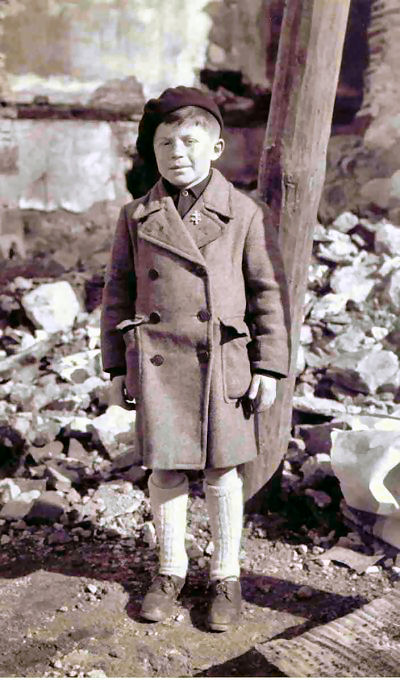The story of Oradour-sur-Glane is one that is central to A Picture of Hope. This post will be the first in a series that takes a deeper look into what I discovered as I researched the book. You can read part two here.
What is the real story behind A Picture of Hope. What were the real events that inspired the book? What is truth and what is fiction?
When I started writing the book, I knew the heroine, Nellie Wilkerson, was a photojournalist, so a photo had to play a major part of the story. But I was at a loss as to how to weave that in, so I spent some time in the National Archives (a great place to get lost in history, by the way), and I knew the picture the instant I saw it.
This is a picture of Roger Godfrin in Oradour-sur-Glane. I was drawn by the look in his eyes, by his rather stoic bearing, and the smile that didn’t really brighten his face.
And then I learned Roger’s story.
In the afternoon of June 10, 1944, the bucolic French village of Oradour-sur-Glane, which had been largely ignored by the Nazis throughout the course of the war, was surrounded by German troops. All citizens were ordered to the town square. The citizens believed this to be nothing more than an ordinary ID check.
They couldn’t have been more wrong.
First, they divided the men from the women. When the townspeople couldn’t produce any of the arms the Germans demanded of them, the soldiers divided the men into six groups, took them to different barns, and shot them.
With that heinous crime done, they marched the women and children to the church, locked them inside, and set fire to the building. Anyone attempting to escape was shot on sight.
Out of that horrific tragedy of Oradour-sur-Glane, only seven people survived. Five were men who were protected by falling bodies. One was a woman, Marguerite Rouffanche, who miraculously survived the church, and one was Roger Godfrin, a schoolchild who had come with his parents from Lorraine and had seen German atrocities before.
There are conflicting accounts of what happened. When Roger grew up, he never spoke much about the incident. Even though it was a Saturday, the children were in school. The Germans arrived and came to the school to round up the students and teachers. There are reports that Roger’s mother ingrained in him what do to if the Nazis ever came.
He managed to escape out the back of the school and into a field. The Germans saw him and shot at him (it is unclear if he was hit), but he managed to make it to the river and hid there, sometimes underneath the hedgerows so famous in that part of France. That is how he managed to stay alive. The story was too tragic and yet so hopeful because some survived from the massacre that I decided I had to use it.
At first, in my mind’s eye, the child in the picture in A Picture of Hope was Jewish. But when I peered closer at the photograph that Nellie took, my imagination discovered a little girl with Down syndrome. And that’s how Claire came to be.

As for Oradour-sur-Glane, the Germans burned the entire village. Though it was almost rebuilt following the war, Charles de Gaulle halted construction. Instead, he ordered the town to be left as it was, a monument to the 192 men, 239 women, and 205 children who perished there on June 10, 1944.
It is a story we should never forget.
That is why I wrote A Picture of Hope.
If you would like to learn more about Oradour-sun-Glane, the National WWII Museum in New Orleans has an excellent article.


Thank you for sharing more of the history behind A Picture of Hope. May we never forget!!
Amen!
Such a tragic story of evil overcome by hope.
what a sad time in history, thanks for writing this book and bringing it to everyone’s attention
This time period in history is both fascinating and appaling. Looking forward to reading your book.
I’m currently reading A Picture of Hope. Even though I’ve previously read about entire villages being burned/shot because of harboring Jews, participating in acts of resistance, etc., picturing that is horrific! I love that Nellie felt compelled to protect and nurture little Claire.